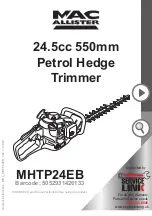
16 ENGLISH
16.
Check the cutting attachment frequently
during operation for cracks or damages.
Before the inspection, remove the battery
cartridge and wait until the cutting attachment
stops completely. Replace damaged cutting
attachment immediately, even if it has only
superficial cracks.
17.
Never cut above waist height.
18.
Before starting the cutting operation, wait until
the cutting attachment reaches a constant
speed after turning the tool on.
19.
When using a cutting blade, swing the tool
evenly in half-circle from right to left, like
using a scythe.
20.
Hold the tool by insulated gripping surfaces
only, because the cutter blade may contact
hidden wiring.
Cutter blades contacting a “live”
wire may make exposed metal parts of the tool
“live” and could give the operator an electric
shock.
21.
Do not start the tool when the cutting tool is
tangled with cut grass.
22.
Before starting the tool, be sure that the cut
-
ting tool is not touching the ground and other
obstacles such as a tree.
23.
During operation always hold the tool with
both hands. Never hold the tool with one hand
during use.
24.
Do not use the tool when there is a risk of
lightning.
25.
When you use the tool on muddy ground, wet
slope, or slippery place, pay attention to your
footing.
26.
Avoid working in poor environment where
increased user fatigue is expected.
27.
Do not use the tool in bad weather where visi-
bility is limited.
Failure to do so may cause fall or
incorrect operation due to low visibility.
28.
Do not submerge the tool into a puddle.
29.
Do not leave the tool unattended outdoors in
the rain.
30.
When wet leaves or dirt adhere to the suc-
tion mouth (ventilation window) due to rain,
remove them.
31.
Do not use the tool in the snow.
Cutting tools
1.
Do not use a cutting tool which is not recom-
mended by Makita.
2.
Use an applicable cutting attachment for the
job in hand.
— Nylon cutting heads (string trimmer heads)
and plastic blades are suitable for trimming
lawn grass.
— Cutting blades are suitable for cutting weeds,
high grasses, bushes, shrubs, underwood,
thicket, and the like.
— Never use other blades including metal
multi-piece pivoting chains and flail blades. It
may result in serious injury.
3.
Only use the cutting tool that are marked with
a speed equal or higher than the speed marked
on the tool.
4.
Always keep your hands, face, and clothes
away from the cutting tool when it is rotating.
Failure to do so may cause personal injury.
5.
Always use the cutting attachment guard prop-
erly suited for the cutting attachment used.
6.
When using cutting blades, avoid kickback
and always prepare for an accidental kickback.
See the section for Kickback.
7.
When not in use, attach the blade cover onto
the blade. Remove the cover before operation.
Kickback (Blade thrust)
1.
Kickback (blade thrust) is a sudden reaction
to a caught or bound cutting blade. Once it
occurs, the tool is thrown sideway or toward
the operator at great force and it may cause
serious injury.
2.
Kickback occurs particularly when applying
the blade segment between 12 and 2 o'clock
to solids, bushes and trees with 3 cm or larger
diameter.
►
Fig.2
3.
To avoid kickback:
1.
Apply the segment between 8 and
11 o'clock.
2.
Never apply the segment between 12 and
2 o'clock.
3.
Never apply the segment between 11 and
12 o'clock and between 2 and 5 o'clock,
unless the operator is well trained and
experienced and does it at his/her own
risk.
4.
Never use cutting blades close to solids,
such as fences, walls, tree trunks and
stones.
5.
Never use cutting blades vertically, for
such operations as edging and trimming
hedges.
►
Fig.3
Vibration
1.
People with poor circulation who are exposed
to excessive vibration may experience injury
to blood vessels or the nervous system.
Vibration may cause the following symptoms
to occur in the fingers, hands or wrists: “Falling
asleep” (numbness), tingling, pain, stabbing sen
-
sation, alteration of skin color or of the skin. If any
of these symptoms occur, see a physician!
2.
To reduce the risk of “white finger disease”,
keep your hands warm during operation and
well maintain the tool and accessories.
Transport
1.
Before transporting the tool, turn it off and
remove the battery cartridge. Attach the cover
to the cutting blade.
2.
When transporting the tool, carry it in a hori-
zontal position by holding the shaft.
3.
When transporting the tool in a vehicle, prop-
erly secure it to avoid turnover.
Otherwise
damage to the tool and other baggage may result.
Summary of Contents for UR012GZ04
Page 2: ...Fig 1 12 2 Fig 2 12 1 2 3 4 5 8 9 10 11 Fig 3 6 7 8 9 10 11 12 13 14 15 16 1 2 3 4 5 Fig 4 2 ...
Page 3: ...1 1 2 3 Fig 5 1 2 Fig 6 2 1 Fig 7 1 2 Fig 8 2 1 Fig 9 2 1 Fig 10 3 2 1 Fig 11 3 ...
Page 7: ...1 Fig 36 Fig 37 Fig 38 Fig 39 7 ...
Page 8: ...1 2 3 5 4 6 7 8 3 m 80 mm 100 mm Fig 40 8 ...
Page 9: ...9 1 2 4 3 5 6 3 m 100 mm Fig 41 ...
















































